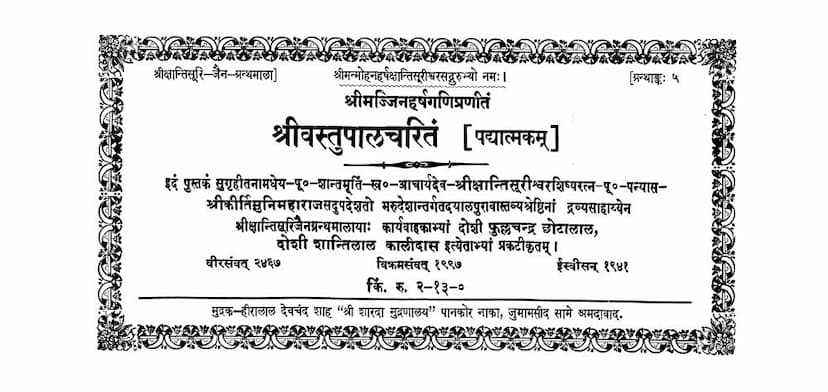Vastupal Charitam
Added to library: September 2, 2025

Summary
Here's a comprehensive summary of the Jain text "Vastupal Charitam" by Jinharshsuri, based on the provided text:
Title: Vastupal Charitam (The Life and Deeds of Vastupal) Author: Jinharshsuri Publisher: Doshi Shantilal Kalidas (published by Shri Kantisuri Jain Granthmala) Year of Publication: Veer Samvat 2467 / Vikram Samvat 1997 / AD 1941
Overall Purpose and Significance:
The "Vastupal Charitam" is a narrative poem composed by Jinharshsuri, detailing the life and remarkable achievements of Vastupal, a prominent minister during the reign of King Viradhaval. The text highlights Vastupal's devotion to Jainism, his administrative skills, military prowess, generosity, and his significant contributions to the Jain faith and society. It is presented as the fifth publication of the Shri Kantisuri Jain Granthmala, made possible by financial assistance from the residents of Dayalpura.
Key Themes and Content:
The book is structured into eight "Prastavas" (sections or chapters), each focusing on different aspects of Vastupal and his brother Tejpal's lives and accomplishments:
-
Birth and Early Life: This section covers the birth of Vastupal and Tejpal from the womb of Kumar Devi, wife of Ashwaraj, and their subsequent marriage. It also describes their initial entry into ministerial service under King Dhaval based on divine guidance.
-
Entering Ministry and Early Achievements: This part details the teachings of Devaprabh Suri, the importance of helping others, and how Vastupal and Tejpal demonstrated their competence in state affairs, amassing wealth for the king. It recounts their journey to Saurashtra and their victory over Sangachamundi, leading to their appointment as ministers.
-
Confrontations with Kings and Victories: This section narrates the conflicts and victories against various rulers. It includes the campaign against Bhim Singh of Bhadresha, the defeat of King Ghunghula of Godha, and the subjugation of Sadik of Stambhatirtha and Shankharaj of Vadvanagar. It also touches upon the importance of spiritual guidance and the stories of the virtuous like Sundar Shreshthiputra.
-
Service to Stambhatirtha and Generosity: This chapter focuses on Vastupal's efforts in Stambhatirtha, his dealings with wicked individuals, and his victories. It mentions the discovery of hidden treasures, the construction of charitable institutions like dharamshalas (rest houses), and the establishment of libraries and water fountains. It also highlights his religious activities and the influence of Narachandrasuri's teachings.
-
Embracing Jainism and Devotion: This section details Vastupal and Tejpal's deep commitment to Jainism after witnessing the effects of aging and receiving guidance from their gurus. It emphasizes their unwavering devotion, their participation in religious festivals, and their role in strengthening the Jain community. The story of King Narvarman is used as an example of the importance of righteousness.
-
Leadership and Societal Contributions: This chapter discusses Vastupal's role as a "Sanghapati" (leader of a religious group) and his profound faith. It recounts his journey with the Sangha, his interactions with influential figures, and his significant contributions to religious sites, including the decoration of idols and the organization of grand festivals. The text also touches upon the challenges faced and the importance of sincere devotion.
-
Confrontation with Yogi-pur Padshah and Generosity: This section narrates Vastupal's confrontation with the Padshah of Yoginipur and his subsequent victory. It highlights his diplomatic skills, his strategic thinking, and his significant generosity, including his contributions to the Hajj pilgrimage and his dealings with the Padshah's mother. The text also mentions his respect for Jain monks and his establishment of various religious and charitable initiatives.
-
Construction of the Nemnath Temple and Philanthropy: The final section details the construction of a magnificent temple for Nemnath. It describes the architectural planning, the involvement of skilled artisans, and the overall grandeur of the project. It also mentions the influence of Anupamadevi (Tejpal's wife) and the respect shown to Vastupal by the king, underscoring his impartial nature and his commitment to religious activities. The text also includes stories about the royal family and their interactions with ministers.
Key Figures:
- Vastupal: The central protagonist, a minister known for his administrative skills, military leadership, generosity, and deep Jain faith.
- Tejpal: Vastupal's brother, who also played a significant role in political and religious affairs.
- Anupamadevi: Tejpal's wife, recognized for her intelligence and wisdom.
- Viradhaval: The king under whom Vastupal and Tejpal served.
- Jinharshsuri: The author of the Charitam.
- Panisyas Shri Kirtimuni: The editor who undertook the painstaking work of compiling and editing the text.
- Various Gurus and Scholars: Including Shri Someshwar, Narachandra Suri, Devaprabh Suri, and others who provided spiritual guidance.
Literary Style and Language:
The text is written in a poetic style, filled with rich descriptions, metaphors, and moral lessons. The language is elevated and often uses Sanskritized Gujarati, reflecting the scholarly and devotional nature of the work.
Overall Contribution:
The "Vastupal Charitam" serves as a valuable historical and religious document, offering insights into the life of a prominent Jain figure and the socio-religious landscape of 12th-century Gujarat. It celebrates virtues like devotion, integrity, generosity, and courage, providing an inspiring narrative for Jain followers and scholars alike. The detailed descriptions of architectural projects, religious practices, and political events offer a glimpse into the era.